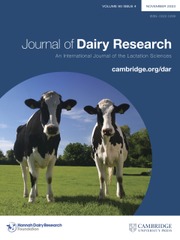No CrossRef data available.
Article contents
Prediction of the staphylococcal enterotoxin A production in simulated Minas Frescal cheese conditions
Published online by Cambridge University Press: 22 October 2025
Abstract
This study aimed to develop a predictive model to investigate the effect of temperature, pH, NaCl concentration, initial inoculum concentration and time on enterotoxin A (SEA) production by Staphylococcus aureus. Combinations of three levels of temperature (10, 15 and 25°C ), five levels of pH (5.3, 5.5, 6.0, 6.5 and 6.7), five levels of NaCl (0.8, 1.0, 1.5, 2.0 and 2.2%), three levels of inoculum concentration (0, 3 and 5 log CFU/mL) in brain heart infusion (BHI) broth were studied. Colonies were counted and SEA production was assessed at 24 h intervals for up to 240 h. A probabilistic logistic regression model was used to describe the production of SEA by Staphylococcus aureus. SEA production was influenced by all factors, except NaCl concentration. S. aureus produced SEA in all samples at 25°C, while the temperature of 10°C delayed the growth and SEA production of S. aureus at initial contamination levels of 3 log CFU/mL and 5 log CFU/mL and prevented it at 0 log CFU/mL. The model was statistically and experimentally validated, demonstrating a good fit, with a high percentage agreement, Nagelkerke's R2 and the Hosmer and Lemeshow test for the SEA production model. The experimental validation confirmed the effectiveness of the models for predicting the probability of SEA production by S. aureus in Minas Frescal cheese.
Keywords
Information
- Type
- Research Article
- Information
- Copyright
- © The Author(s), 2025. Published by Cambridge University Press on behalf of Hannah Dairy Research Foundation.

